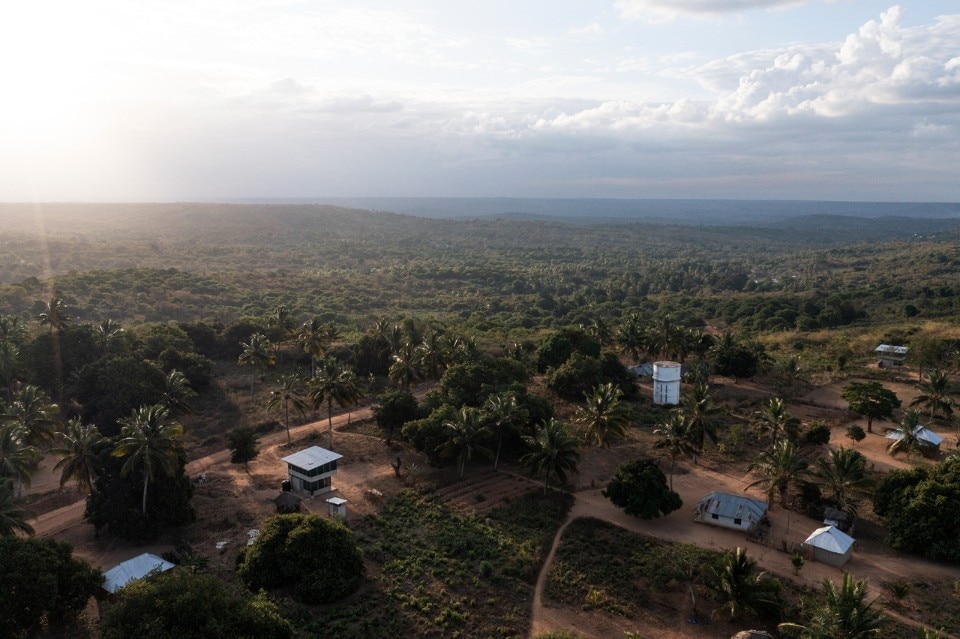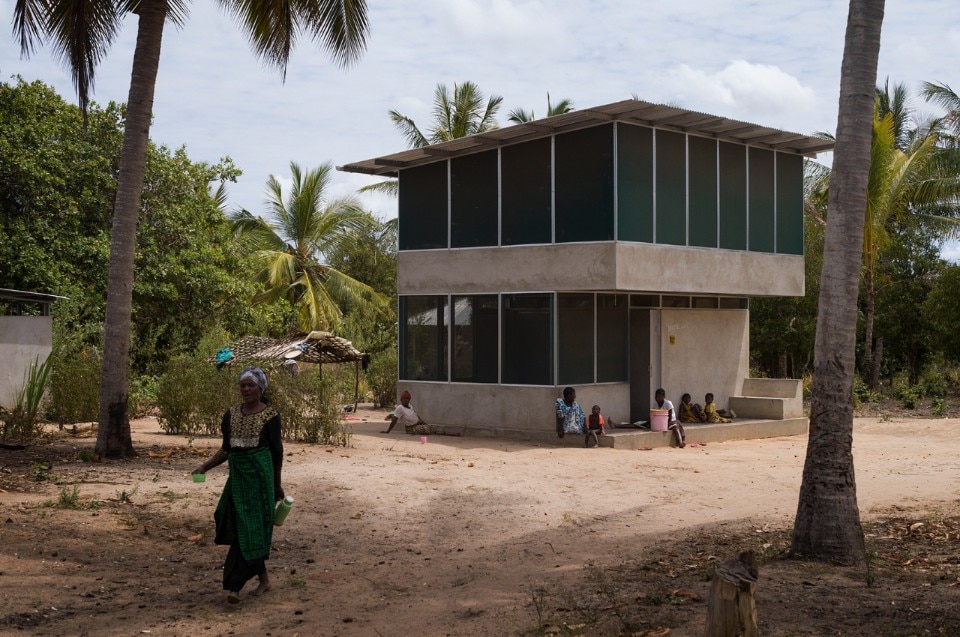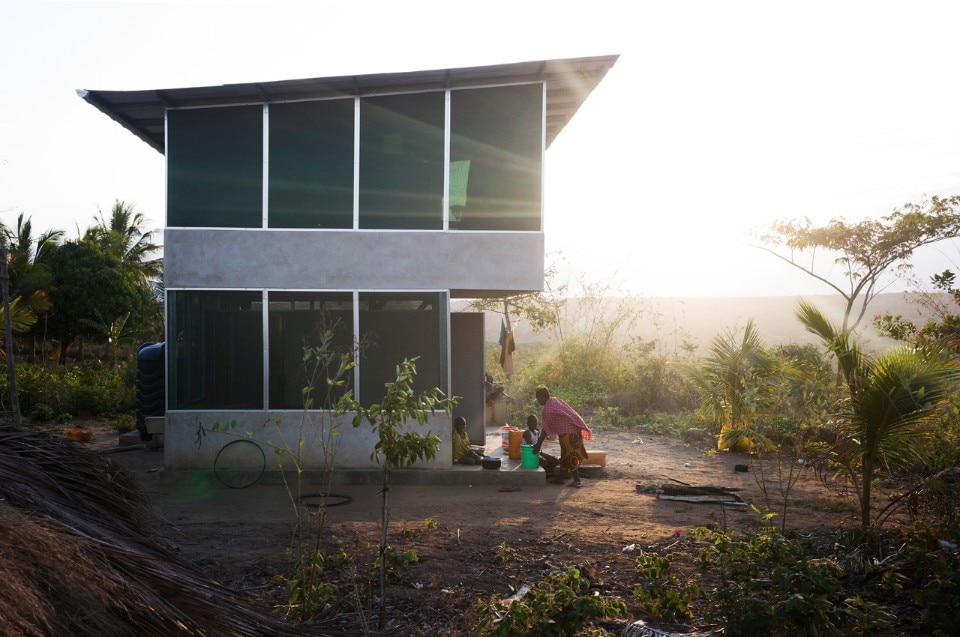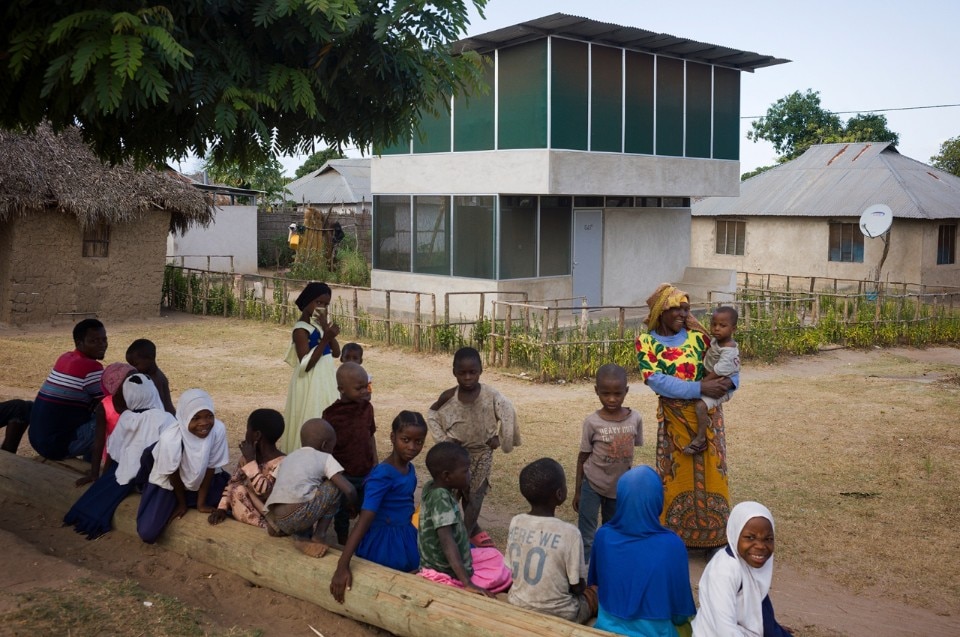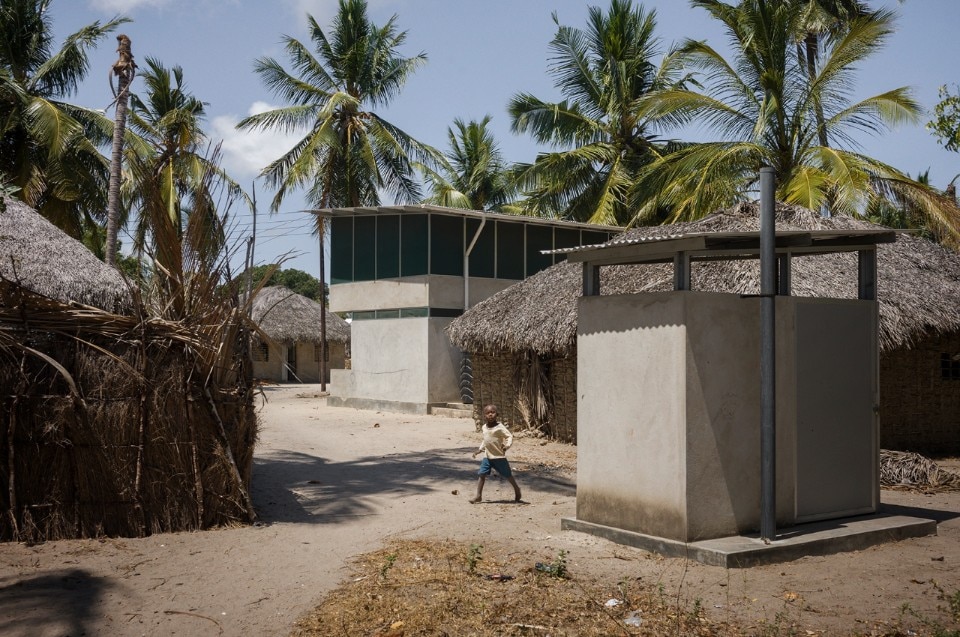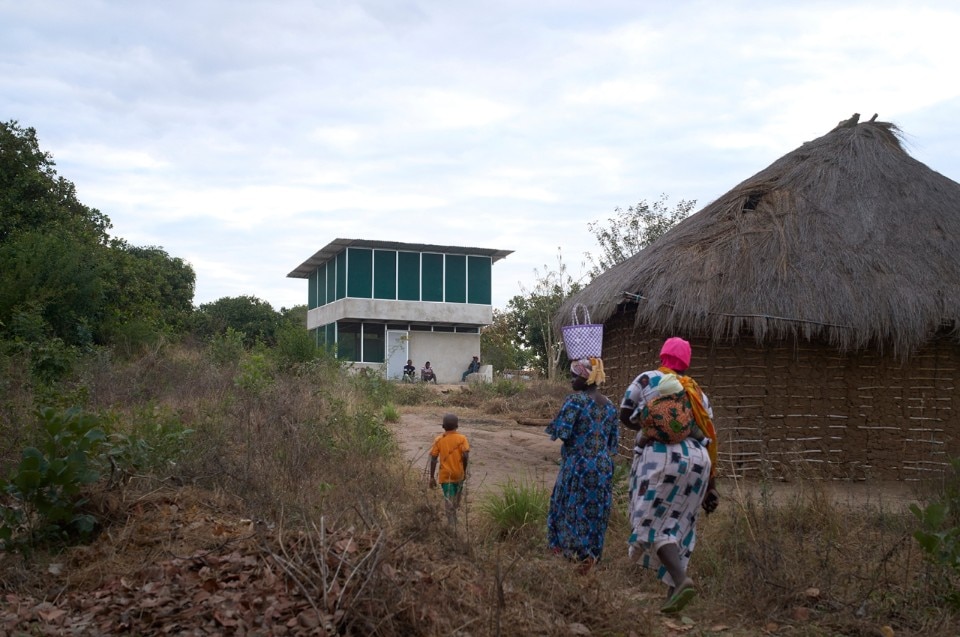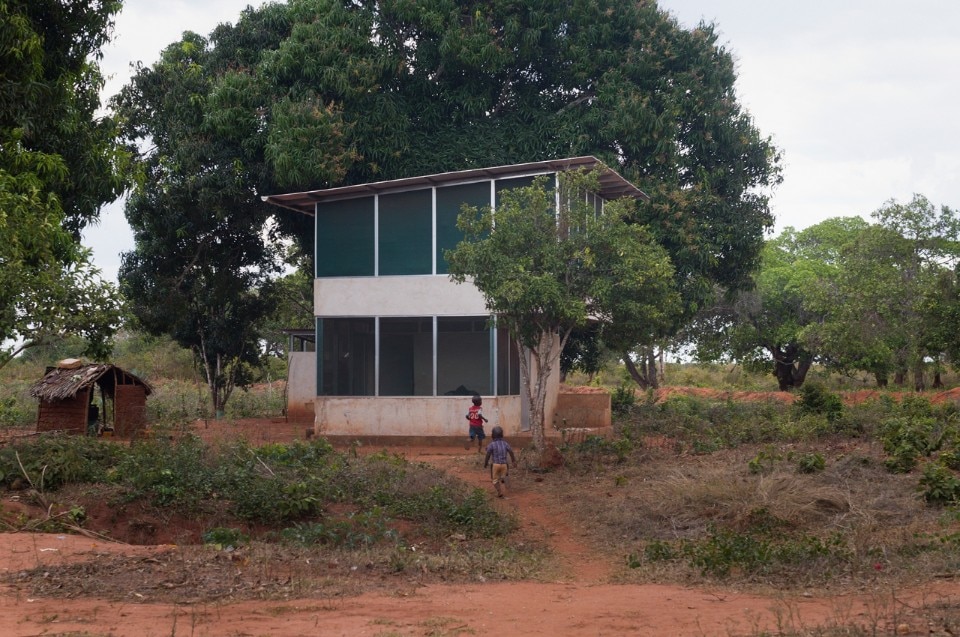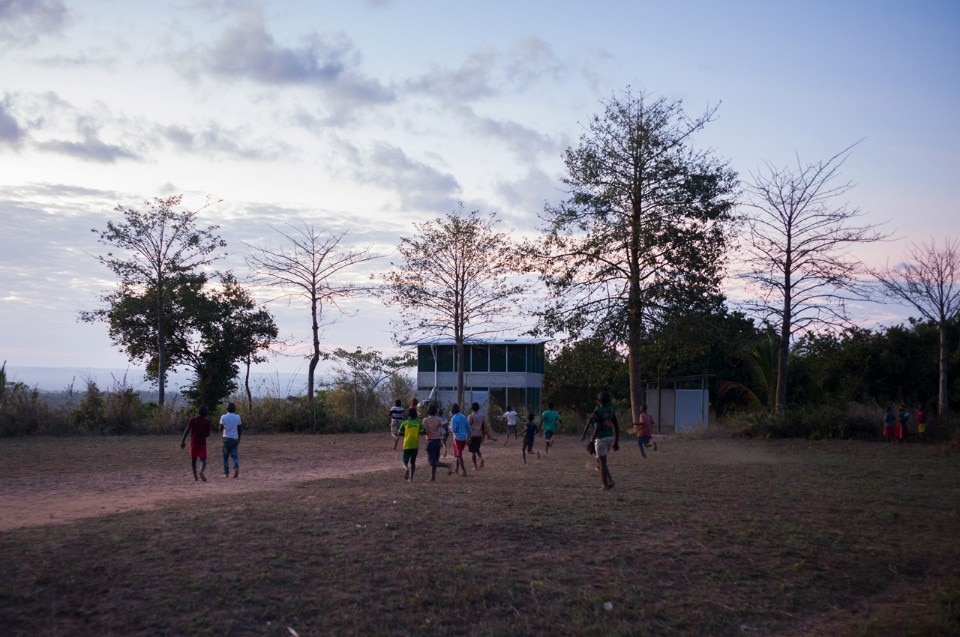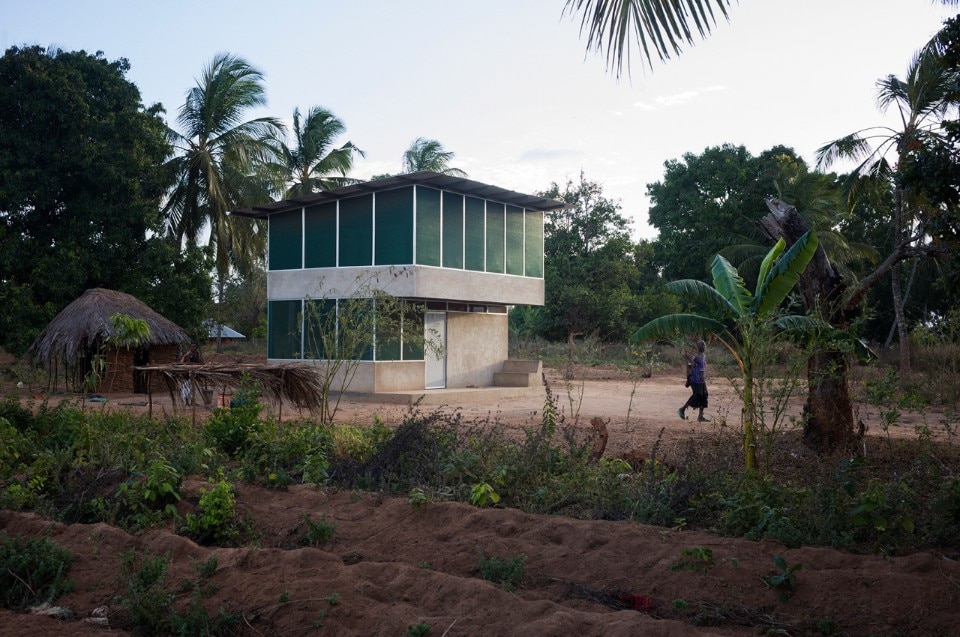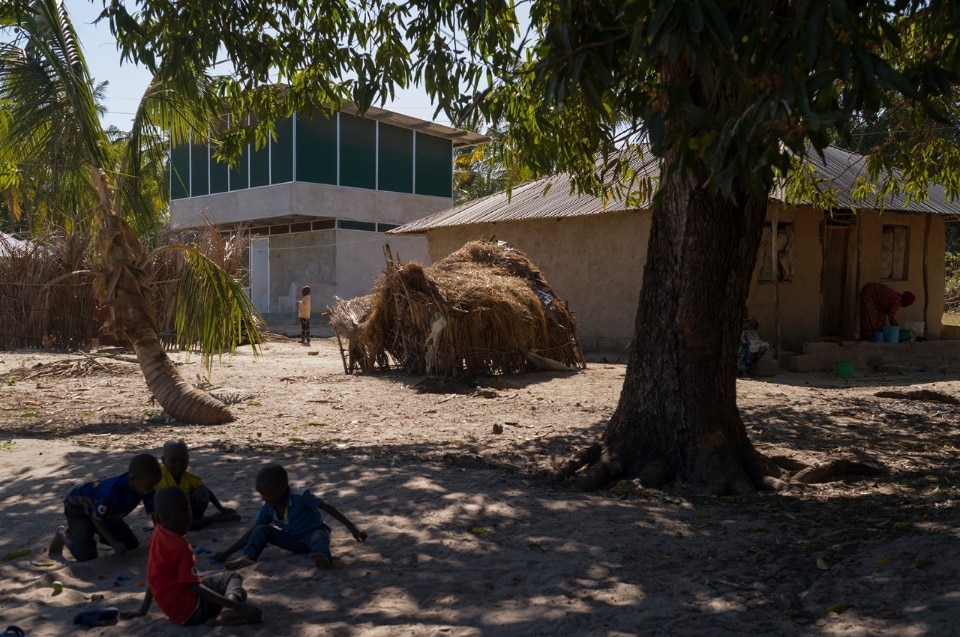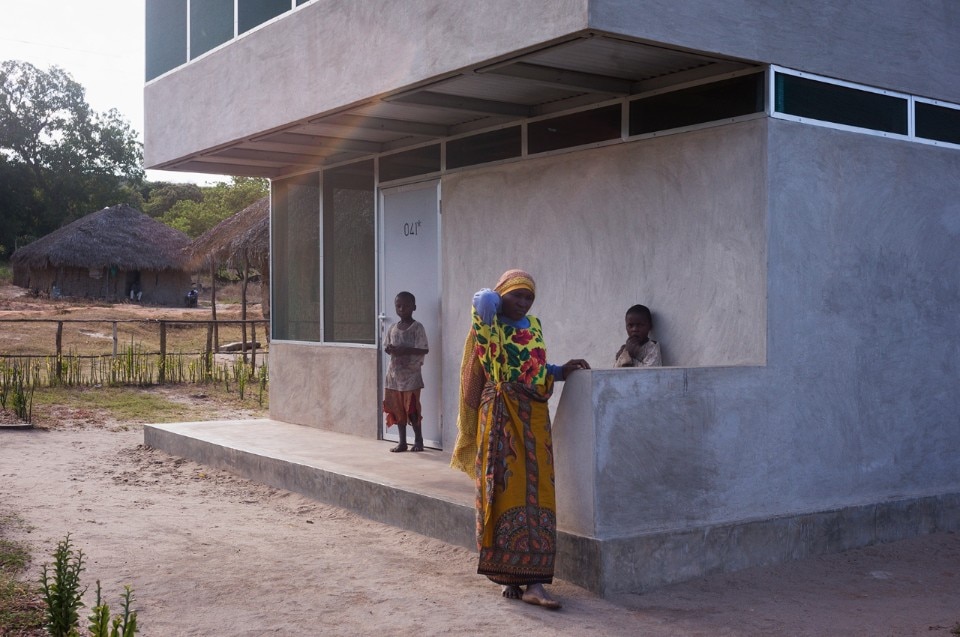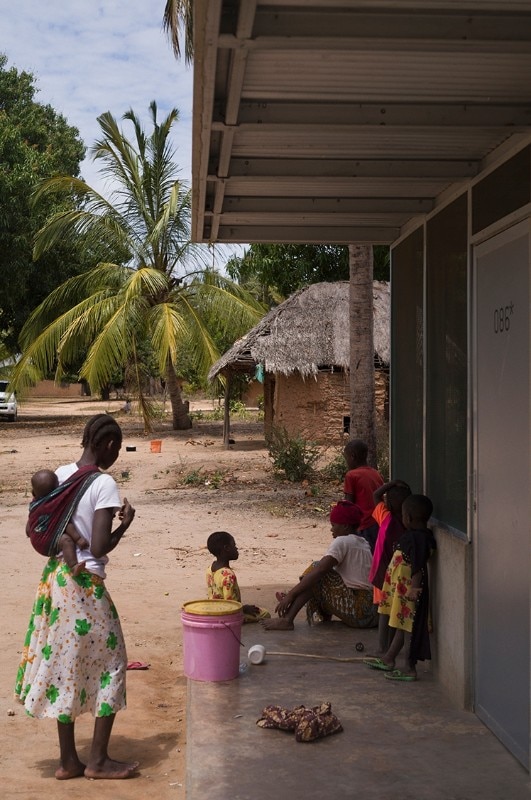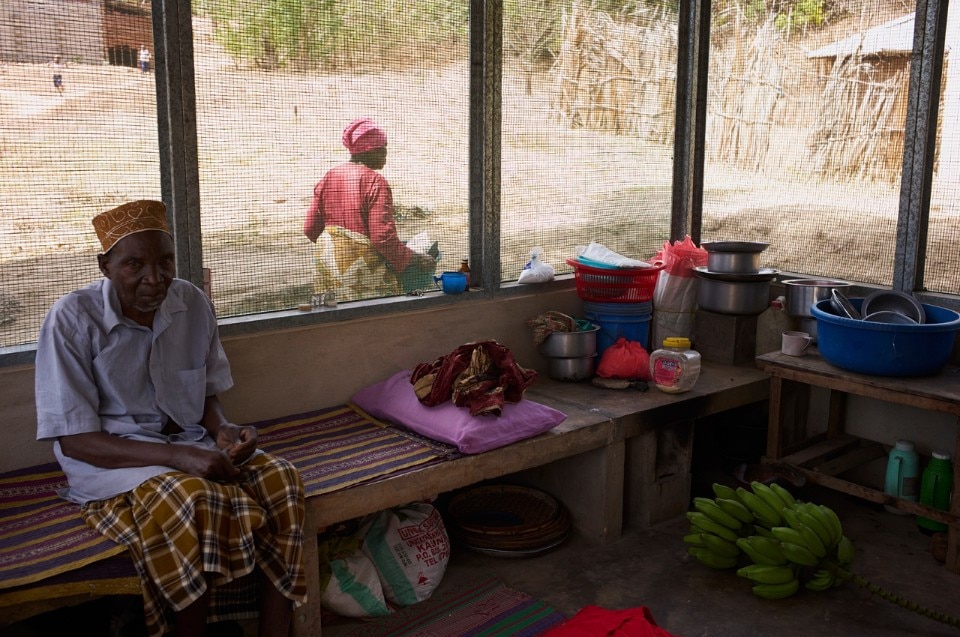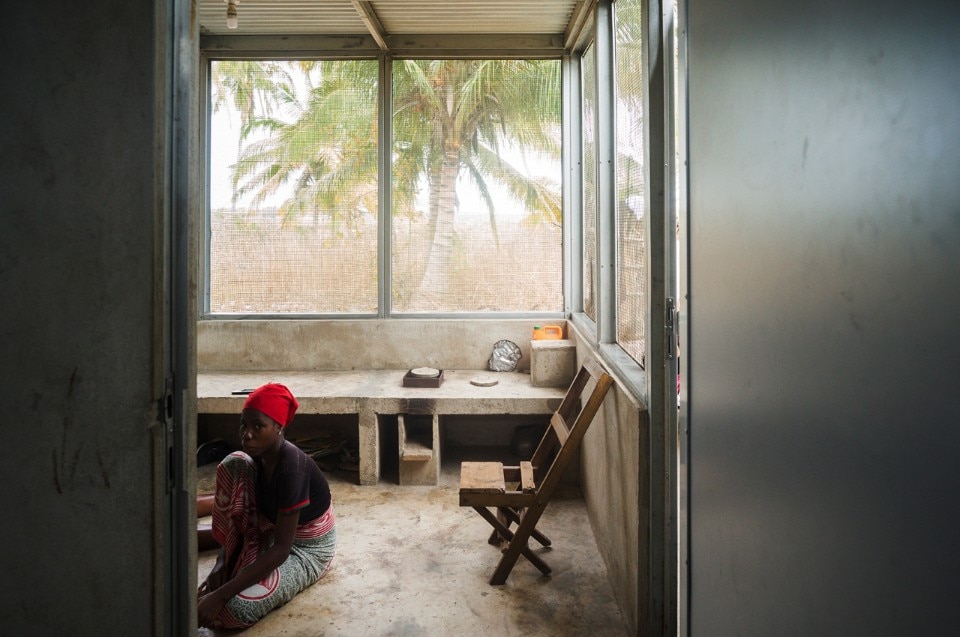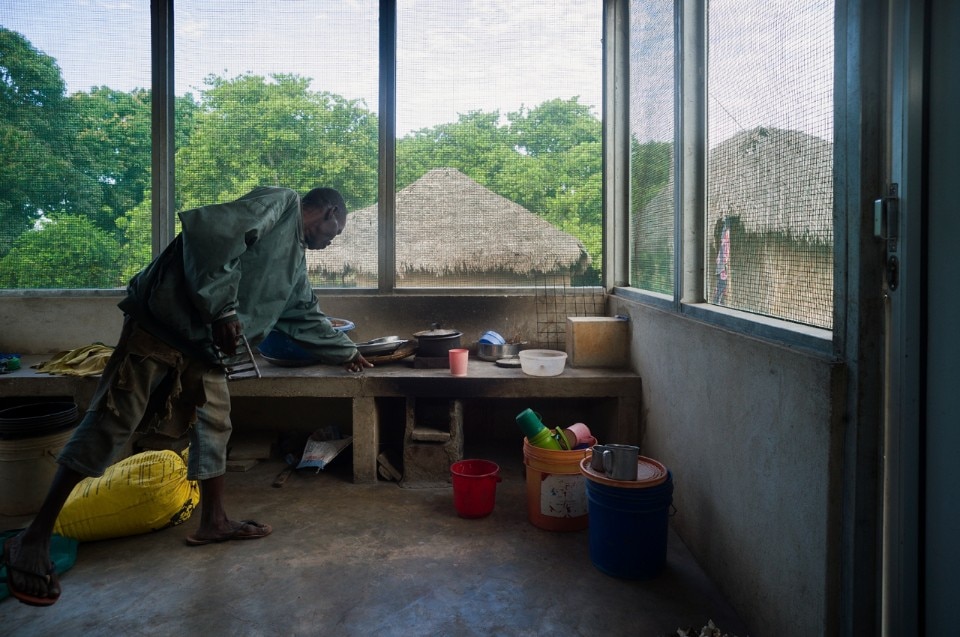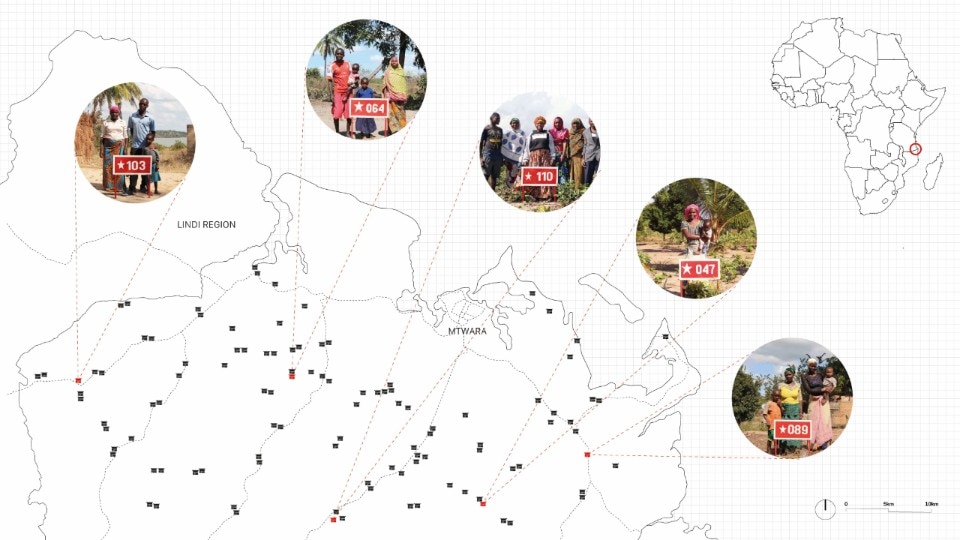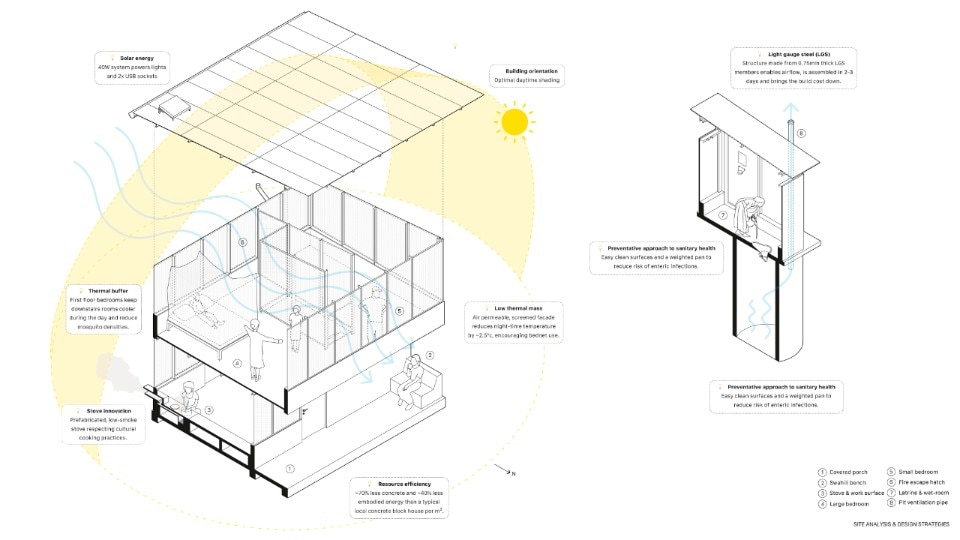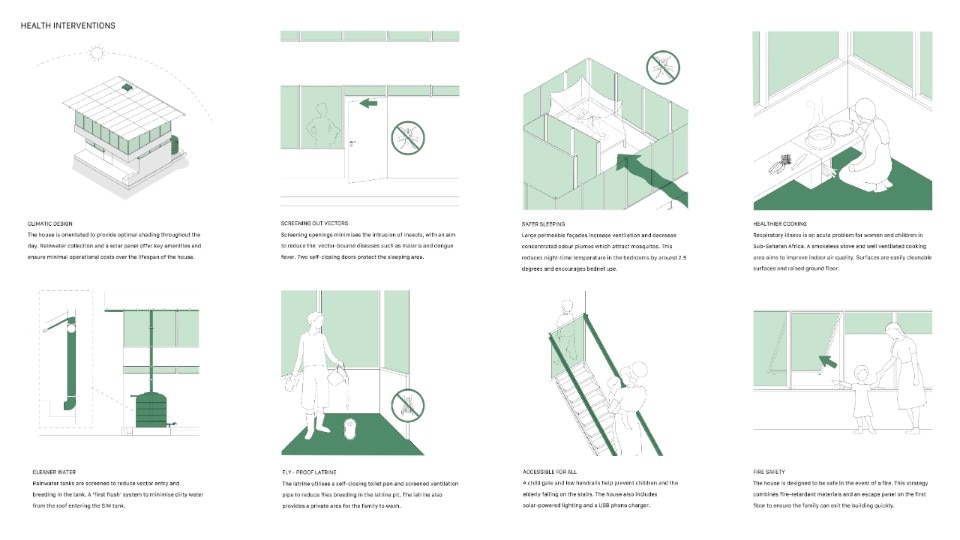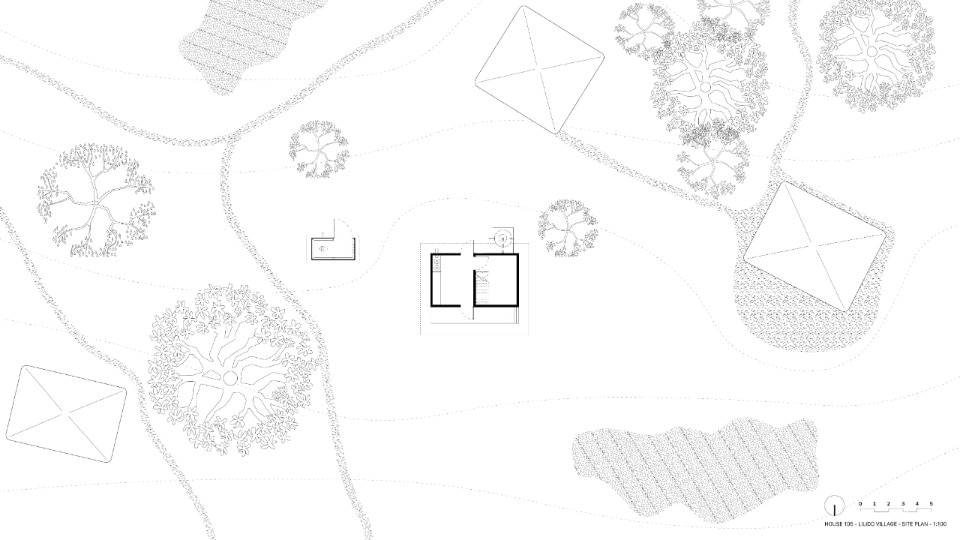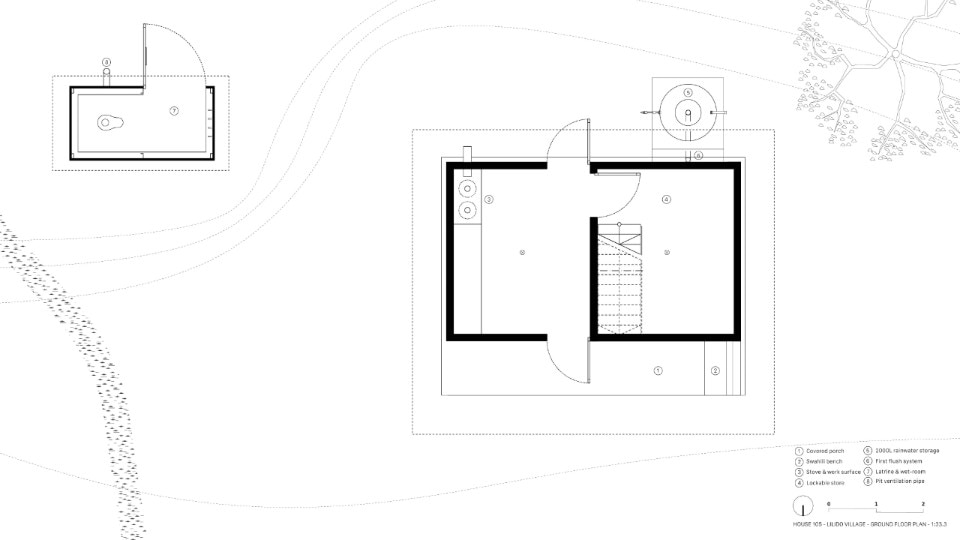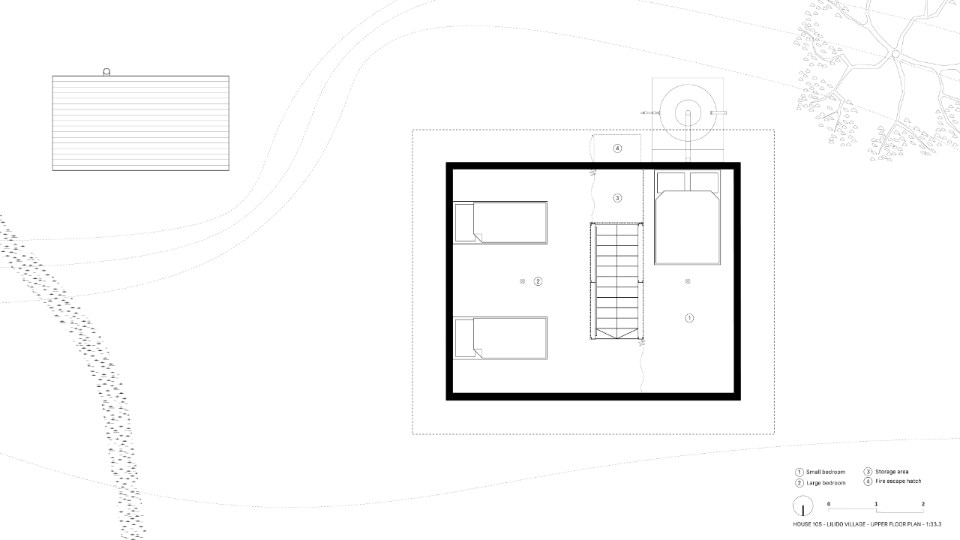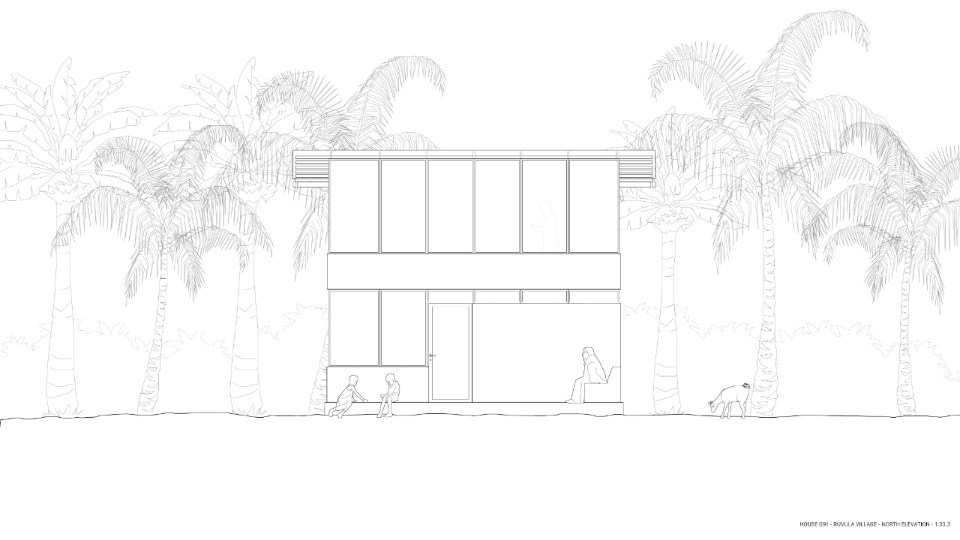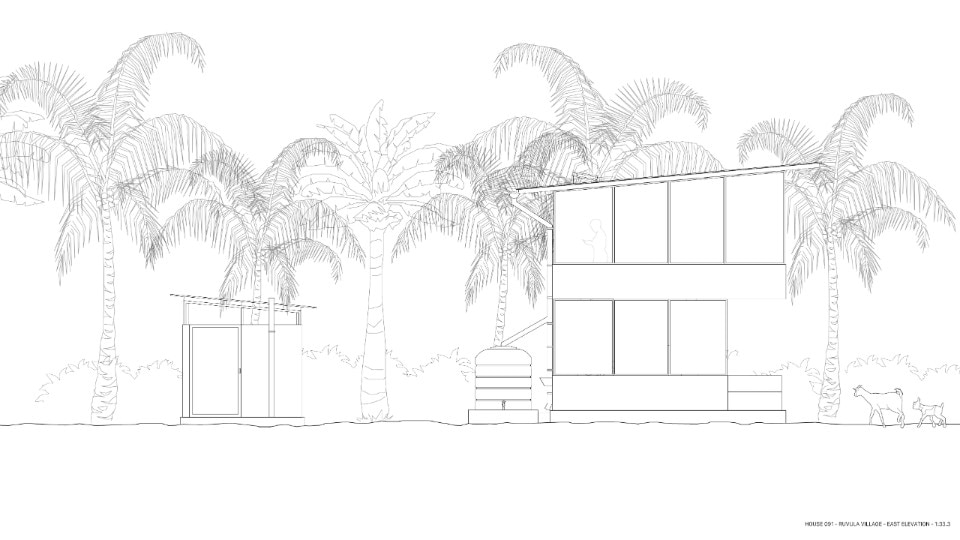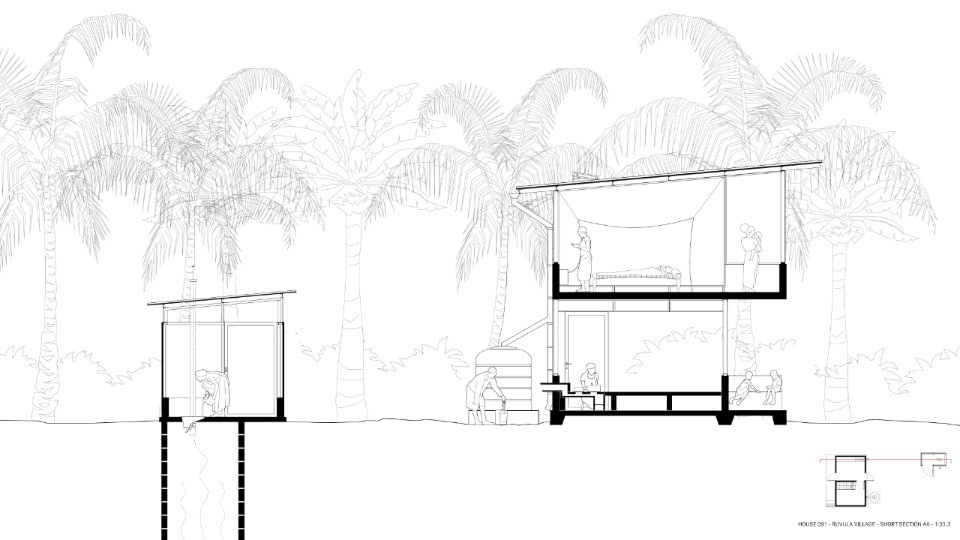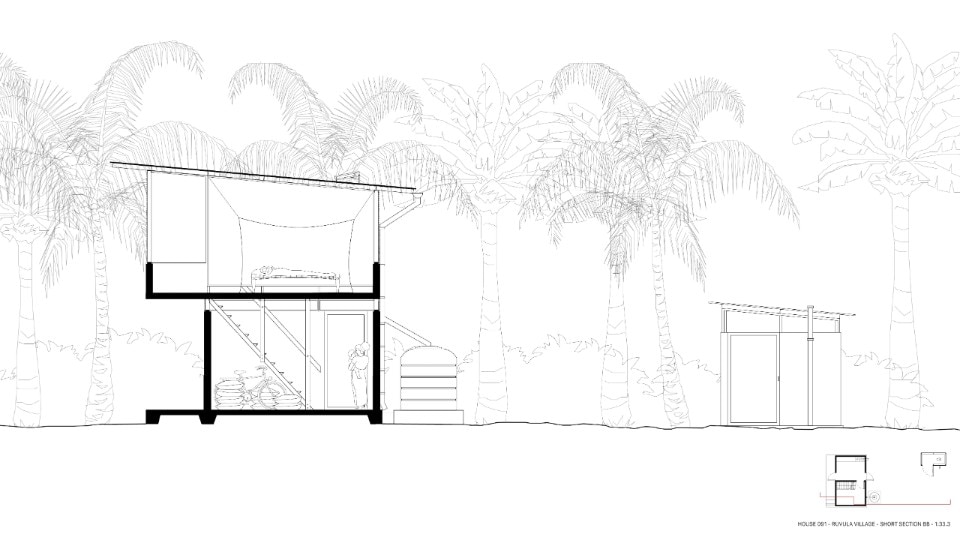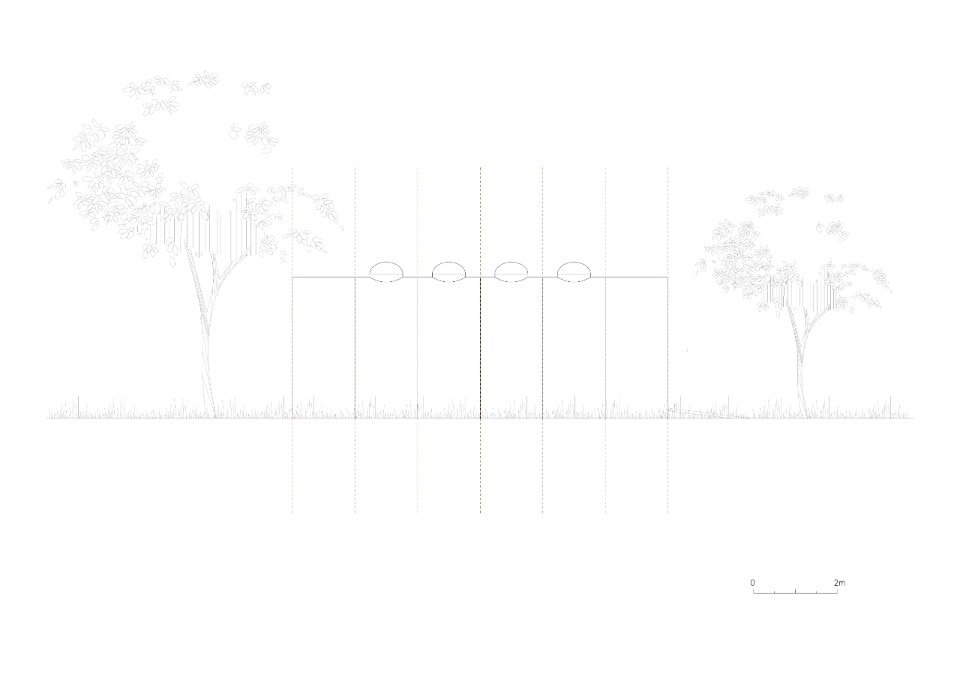by Alessandro Benetti
The minimalist home has not always been an architectural theme. In the Western world, design culture has associated a certain size – minimal – with a certain function – housing – only in the last century. Primarily, the minimalist home has been intended as the initial house for everyone. Beginning from the late 1910s, architects belonging to the Modern Movement, who held socialist and progressive ideals, created two distinct types of designs: extravagant mansions as manifestos for wealthy and educated clients, and small but “dignified” dwellings to be mass-produced in large quantities. The modernist existenzminimum, available in various forms, embodies simplicity and lacks ornamentation, as these features are essential for enabling industrialization and the construction of vast quantities in a truly democratic manner.
A few decades later, in the 1950s and 1960s, a period often characterized as carefree, marked by newfound prosperity and changing social norms, the minimalist home took on a new role as a vacation home. With the rise of mass tourism, the aspiration of owning a second home for vacations became attainable for many. Initially, this trend involved simplifying and minimizing the domestic space to cater specifically to temporary occupation, usually for a few months each year. Later, the advent of experimentation with plastics led to a significant transformation in vacation homes. The minimalist home evolved into a modular shell, characterized by its lightweight and foundation-less structure, making it easily disassembled and portable. This modular nature allowed the minimalist home to travel with its occupants when needed.
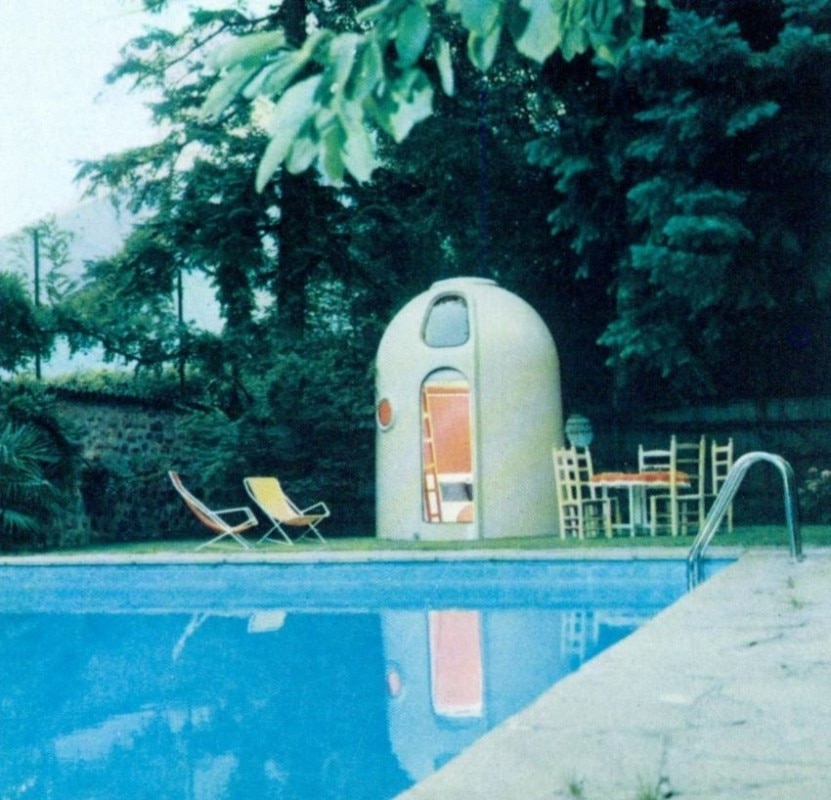
From the end of World War II to the present day, a significant line of thought about minimalist housing has seen it as a viable solution for emergency situations. A subtle thread connects the prefabricated wood and corrugated iron houses designed by Jean Prouvé in France in the 1940s and 1950s, which were primarily intended to provide shelter for displaced and homeless people, with so many recent projects by notable designers. These projects have been conceived in response to catastrophic events such as wars, earthquakes, and tsunamis, as well as to address the ongoing housing crisis in the world’s poorest regions. In such cases, the role of the designer becomes one of mediator and balancer, facing the challenging task of reconciling the need for cost-effectiveness with the pursuit of quality, speed of construction, robustness, and durability.
This brief roundup offers a selection of the most captivating minimalist homes designed from the early twentieth century to the present, featuring snippets sourced directly from the Domus archives. While the compilation is not exhaustive, as it focuses solely on individual houses and omits apartments within residential buildings, it still provides a glimpse into the importance and variety of challenges architects face when creating minimalist homes. In an era characterized by dwindling resources and successive global crises, the subject is more relevant than ever.
Casa minima, V Triennale
Alessandro Cairoli, G.B. Varisco and Osvaldo Borsani, Milan, 1933.jpg)
 View gallery
View gallery
.jpg.foto.rmedium.png)
Alessandro Cairoli, G.B. Varisco e Osvaldo Borsani, Casa minima alla V Triennale, Milano, 1933
Courtesy Triennale Milano
.jpg.foto.rmedium.png)
Alessandro Cairoli, G.B. Varisco e Osvaldo Borsani, Casa minima alla V Triennale, Milano, 1933
Courtesy Archivio Borsani
.jpg.foto.rmedium.png)
Alessandro Cairoli, G.B. Varisco e Osvaldo Borsani, Casa minima alla V Triennale, Milano, 1933
Courtesy Triennale Milano
.jpg.foto.rmedium.png)
Alessandro Cairoli, G.B. Varisco e Osvaldo Borsani, Casa minima alla V Triennale, Milano, 1933
Courtesy Triennale Milano
.jpg.foto.rmedium.png)
Alessandro Cairoli, G.B. Varisco e Osvaldo Borsani, Casa minima alla V Triennale, Milano, 1933
Courtesy Triennale Milano
.jpg.foto.rmedium.png)
Alessandro Cairoli, G.B. Varisco e Osvaldo Borsani, Casa minima alla V Triennale, Milano, 1933
Courtesy Triennale Milano
.jpg.foto.rmedium.png)
Alessandro Cairoli, G.B. Varisco e Osvaldo Borsani, Casa minima alla V Triennale, Milano, 1933
Courtesy Triennale Milano
.jpg.foto.rmedium.png)
Alessandro Cairoli, G.B. Varisco e Osvaldo Borsani, Casa minima alla V Triennale, Milano, 1933
Courtesy Archivio Borsani
.jpg.foto.rmedium.png)
Alessandro Cairoli, G.B. Varisco e Osvaldo Borsani, Casa minima alla V Triennale, Milano, 1933
Courtesy Archivio Borsani
.jpg.foto.rmedium.png)
Alessandro Cairoli, G.B. Varisco e Osvaldo Borsani, Casa minima alla V Triennale, Milano, 1933
Courtesy Archivio Borsani
.jpg.foto.rmedium.png)
Alessandro Cairoli, G.B. Varisco e Osvaldo Borsani, Casa minima alla V Triennale, Milano, 1933
Courtesy Triennale Milano
.jpg.foto.rmedium.png)
Alessandro Cairoli, G.B. Varisco e Osvaldo Borsani, Casa minima alla V Triennale, Milano, 1933
Courtesy Archivio Borsani
.jpg.foto.rmedium.png)
Alessandro Cairoli, G.B. Varisco e Osvaldo Borsani, Casa minima alla V Triennale, Milano, 1933
Courtesy Triennale Milano
.jpg.foto.rmedium.png)
Alessandro Cairoli, G.B. Varisco e Osvaldo Borsani, Casa minima alla V Triennale, Milano, 1933
Courtesy Triennale Milano
.jpg.foto.rmedium.png)
Alessandro Cairoli, G.B. Varisco e Osvaldo Borsani, Casa minima alla V Triennale, Milano, 1933
Courtesy Triennale Milano
.jpg.foto.rmedium.png)
Alessandro Cairoli, G.B. Varisco e Osvaldo Borsani, Casa minima alla V Triennale, Milano, 1933
Courtesy Triennale Milano
.jpg.foto.rmedium.png)
Alessandro Cairoli, G.B. Varisco e Osvaldo Borsani, Casa minima alla V Triennale, Milano, 1933
Courtesy Triennale Milano
.jpg.foto.rmedium.png)
Alessandro Cairoli, G.B. Varisco e Osvaldo Borsani, Casa minima alla V Triennale, Milano, 1933
Courtesy Archivio Borsani
.jpg.foto.rmedium.png)
Alessandro Cairoli, G.B. Varisco e Osvaldo Borsani, Casa minima alla V Triennale, Milano, 1933
Courtesy Archivio Borsani
.jpg.foto.rmedium.png)
Alessandro Cairoli, G.B. Varisco e Osvaldo Borsani, Casa minima alla V Triennale, Milano, 1933
Courtesy Archivio Borsani
During the 1930s, the Triennales provided fertile grounds for intensive experimentation with the theme of housing. Prominent rationalist architects of the time showcased their innovative ideas by constructing prototype houses with various themes. For instance, at the IV Triennale in 1930, Gruppo 7 presented the Casa Elettrica (Electric House), while the VI Triennale in 1936 featured the Casa del sabato per gli sposi (Saturday House for Newlyweds), designed by B.B.P.R. with Piero Portaluppi. The V Triennale, held in 1933 at the Palazzo dell’Arte in Milan and Parco Sempione, witnessed the debut of the young Osvaldo Borsani, aged only 22, in the world of architecture. Borsani presented his proposal for a Casa Minima (Minimalist House). Despite its modest dimensions, the interiors were anything but simple, not least because the Triennale focuses on displaying modern products and objects. Notable features of this small temporary building included linoleum floors in various colors – brown in the foyer and light gray in the living room – as well as colored inlays in some of the furniture, such as the orange lacquered details of the bookcase. Casa Minima survives in the author’s drawings and a few photographs of the time.
Igloo Houses
Mario Cavallé, Milan, 1946.jpg)
 View gallery
View gallery
.jpg.foto.rmedium.png)
Mario Cavallé, Igloo Homes, Milan, 1946
Source: SkyScraperCity - Milano Quartiere Maggiolina, from wikimedia commons
.jpg.foto.rmedium.png)
Mario Cavallé, Igloo Homes, Milan, 1946
Source: SkyScraperCity - Milano Quartiere Maggiolina, from wikimedia commons
Indeed, minimalist houses do not necessarily conform to the stereotypical image of cubes or parallelepipeds that the Western eye often associates with simplicity and economy. An excellent example of this is Milan’s famous Igloo Homes, squeezed between the more conventional buildings of the Villaggio dei giornalisti (Journalists’ Village) and the railway. Built shortly after the end of World War II by the talented structural engineer Mario Cavallé, these unique dwellings consist of a group of very inexpensive circular dwellings. The interior rooms of these houses, originally comprising an entrance hall, a bathroom, two bedrooms, and a kitchen, are arranged under a brick dome. Cavallé carefully engineered this dome using hollow bricks arranged in a diamond shape, which were specifically fine-tuned for this project and ensured structural solidity. The design of these minimalist homes allowed for experimentation on both formal and technological levels. Initially intended to be temporary, these igloo homes were saved from demolition in the 1960s thanks to the efforts of their inhabitants, supported by a few enthusiasts and a protagonist of modern Milanese architecture, Luigi Figini.
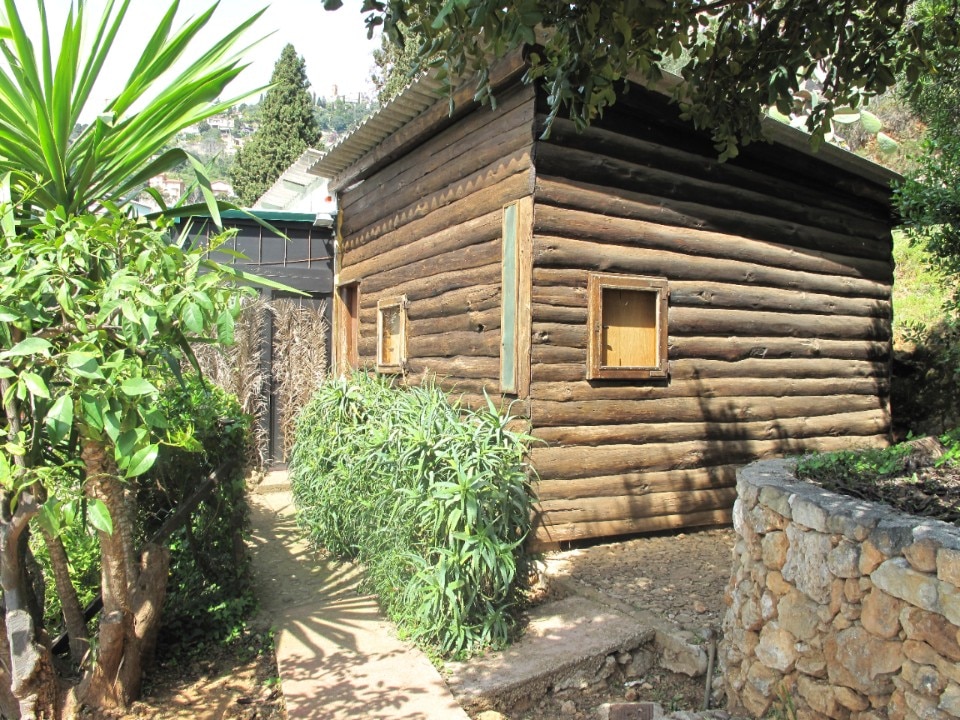
Le Corbusier’s Cabanon is perhaps the most famous minimalist vacation home of the twentieth century. Built in 1951 by the celebrated European modernist for his personal use, this renowned structure is located in Roquebrune-Cap-Martin on the French Riviera. As he gradually retired, Le Corbusier spent much of his old age at the Cabanon, until the unfortunate and famous heart attack that claimed his life in 1965 while swimming in the waters off the cliff. The small cabin, measuring only 366 x 366 cm in plan and 266 cm in height, is both a manifesto of the architect’s work and a testament to his capacity for innovation and self-betrayal. The interior is a modular and highly adaptable open space – an automatic transcription of the principles of the Modulor, Le Corbusier’s system of proportions based on the human scale, which he developed and applied in projects such as the Unité d’Habitation in Marseille (1947-1952). While references to pre-war rationalism can be seen in the primary colors of the furnishings, the exterior is a vernacular wooden shell, not at all purist, perforated by openings that seem to have forgotten the principle of the horizontal window, enunciated in 1926 among the Five Points of New Architecture. The Cabanon presents the work of a mature, “maritime” Corbusier, who embraced and immersed himself in the context of Mediterranean nature, experimenting with a style – both architectural and living – that was light years away from the radical machinism of his heroic 1920s period.
Demountable House “Les jours meilleurs”
Jean Prouvé, 1956
“Les jours meilleurs” (“The best days”) is the optimistic title that Jean Prouvé, the French engineer and pioneer of prefabrication, gave to the prototype of a minimalist modular house built in 1956 in response to a heartfelt appeal by Abbé Pierre. A few months earlier, the deaths of two homeless people from frostbite had caused a scandal on national radio, and public opinion was more sensitive than ever to the issue of housing. The prototype was exhibited at that year’s Salon des Arts Ménager, on the banks of the Seine near the Alexandre III bridge, where it was well received. It was a showcase of the most advanced materials and technologies of the time, put at the service of speed of execution, cost containment, and comfort. The house had a concrete basement, a prefabricated steel central block housing all the essential services, wooden panels mounted on an axial portal frame, and an aluminum projecting roof. Prouvé’s excellent work, however, was not enough to secure its fortune and mass production. The design was considered too avant-garde for its time and could not be homologated due to strict French regulations. Powerful concrete construction lobbies also showed little interest. Sadly, the “Les jours meilleurs” house would be built in only a few examples.
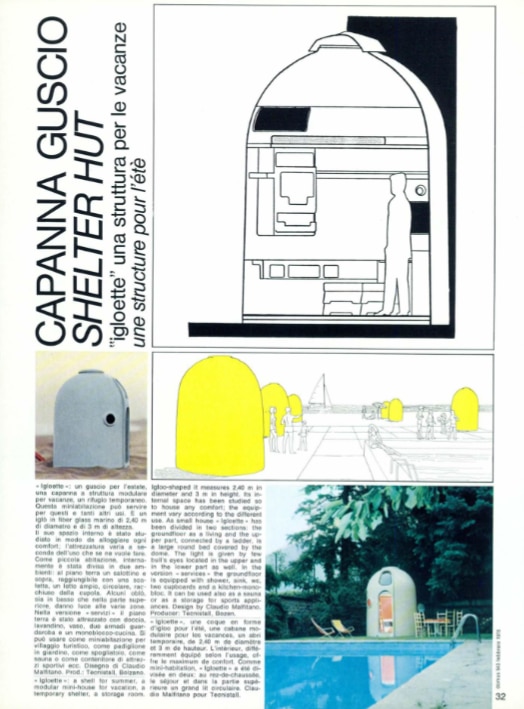
The Igloette, designed by Claudio Malfitano in the mid-1970s, is indeed a prime example of minimalism. Domus devoted a brief overview of it in issue 543, February 1975, describing it as “a shell for the summer, a modular hut for the holidays, a temporary refuge”. Its design features a playful and somewhat peculiar shape reminiscent of a panettone (a traditional Milanese dessert), a bollard, and even a large glass bell. The Igloette’s circular plan has a diameter of 2.4 meters, with the dome’s peak reaching 3 meters in height. The interior can be configured either as a mini-dwelling, with the living area on the ground floor and a half-bed, or as a service cabin with a shower, bathroom and kitchen. The structure itself is a thin, lightweight fiberglass shell.
Vacation Home
Michael Jantzen, United States, 1977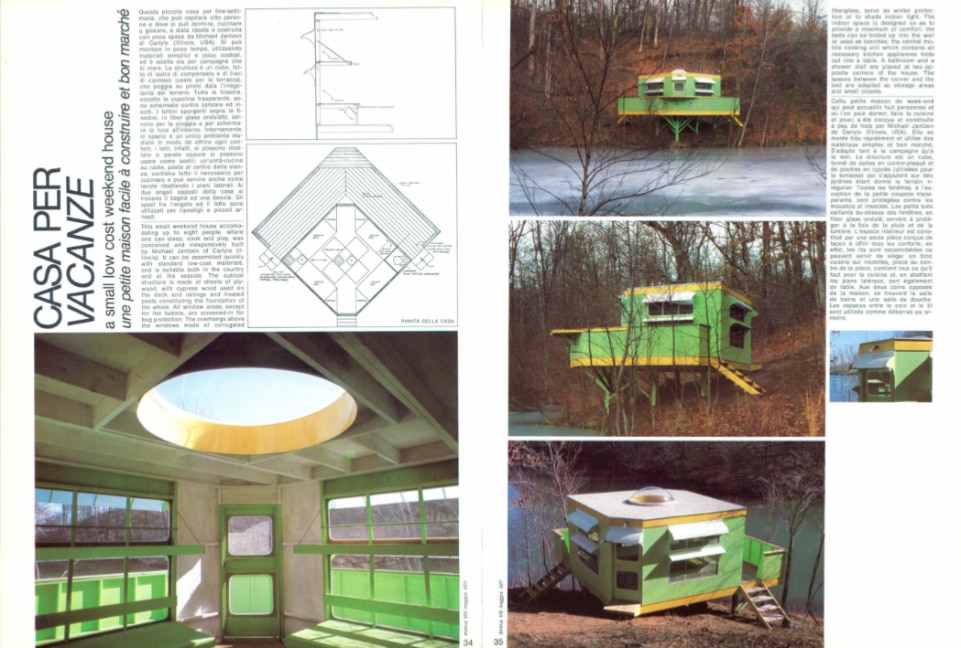
At the turn of the 1970s, Domus intercepted an intriguing design for a minimalist, inexpensive vacation home by Michael Jantzen, an Illinois-based architect who, though little known in Europe, remains prolific and active to this day. Images published in issue 570, May 1977, show the prototype on the banks of a generic Midwestern river. Its vibrant colors – a well-saturated, distinctly 1970s yellow and green – created a striking contrast against the autumnal wooded surroundings. The cottage was constructed entirely of wood, using cypress beams and plywood panels. The interior was stripped down to its bare essentials: a square open area with beds for eight guests that could be folded against the wall or used as sofas, and a mobile kitchen module with a pull-out table top. Each corner of this space had a specific function, housing the entrance door, a panoramic window, a bathroom, and a shower. Natural light flooded the interior of the house, thanks to a large and perfectly circular skylight, perhaps reminiscent of the prominent circular cuts seen in American art in the 1970s.
Post tsunami housing
Shigeru Ban, Sri Lanka, 2007
Shigeru Ban’s minimalist house in Kirinda, a small village on the Sri Lankan coast devastated by the 2004 tsunami, is a highly sophisticated exercise in contextualization. The design only uses locally sourced materials. The load-bearing walls are made of raw earth, while the double-pitched roof, cladding, and interior furnishings are crafted from teak and coconut wood. The many openings, the fixed grids in the façade and the gap at the junction of the vertical surfaces with the roof allow natural air circulation, a valuable resource against the hot and humid climate of the area. In addition, the layout of the space complies with government regulations, ensuring that areas such as the kitchen and bathroom are separated from the rest of the house. It also takes into account the needs of the local population, mainly Muslim fishermen and their families. Inside the living quarters, pivoting wooden screens allow for the separation of men’s and women’s areas. The open but covered space that connects the main room to the services becomes the central living area of the house, providing ample space for family gatherings, children’s play, and the repair of fishing nets. Approximately 100 examples of this minimalist house have been built in Kirinda through the efforts of developer Philip Bay. Shigeru Ban’s commitment to emergency housing continues on numerous other occasions, including after the 2011 tsunami in Japan.
Star Homes Project
Ingvartsen Architects, Mtwara, Tanzania, 2021
 View gallery
View gallery
The design of the minimalist Star Home in a remote rural area of Tanzania was driven primarily by the critical issue of sanitation. Inadequate living conditions in the region contribute to the spread of diseases such as malaria, dysentery and respiratory infections. To address these challenges, a multidisciplinary team, led by Danish firm Ingvartsen Architects and including doctors and entomologists, collaborated to create the Star Home prototype, which has been replicated in 110 units and completed in 2021. The small, steel-framed units feature large areas of breathable mesh for optimal natural ventilation and continuous airing of rooms. The design effectively keeps insects out through the strategic use of self-closing doors and separates the second-floor rooms from the food preparation and consumption space on the ground floor. Most importantly, the Star Home successfully isolates the latrine from the rest of the dwelling by placing it in a small, self-contained volume. Despite its pragmatic approach and limited budget, the Star Home does not compromise on architectural research, both in terms of spatial arrangement – with simple and disciplined floor plans – and linguistic expression – the design exhibits a dry elegance. Adding a poetic element to the dwelling, an outdoor bench adjacent to the front door suggests the continuity of domestic life within the village space.
Essential Homes Research Project
Holcim and Norman Foster Foundation, Venice, 2023.jpg)
 View gallery
View gallery
.jpg.foto.rmedium.png)
Norman Foster Foundation per Holcim, Essential Homes Research Project, 2023
Foto © Chiara Becattini
.jpg.foto.rmedium.png)
Norman Foster Foundation per Holcim, Essential Homes Research Project, 2023
Foto © Chiara Becattini
.jpg.foto.rmedium.png)
Norman Foster Foundation per Holcim, Essential Homes Research Project, 2023
Foto © Chiara Becattini
.jpg.foto.rmedium.png)
Norman Foster Foundation per Holcim, Essential Homes Research Project, 2023
Foto © Chiara Becattini
.jpg.foto.rmedium.png)
Norman Foster Foundation per Holcim, Essential Homes Research Project, 2023
Foto © Chiara Becattini
.jpg.foto.rmedium.png)
Norman Foster Foundation per Holcim, Essential Homes Research Project, 2023
Foto © Chiara Becattini
.jpg.foto.rmedium.png)
Norman Foster Foundation per Holcim, Essential Homes Research Project, 2023
Foto © Chiara Becattini
.jpg.foto.rmedium.png)
Norman Foster Foundation per Holcim, Essential Homes Research Project, 2023
Foto © Chiara Becattini
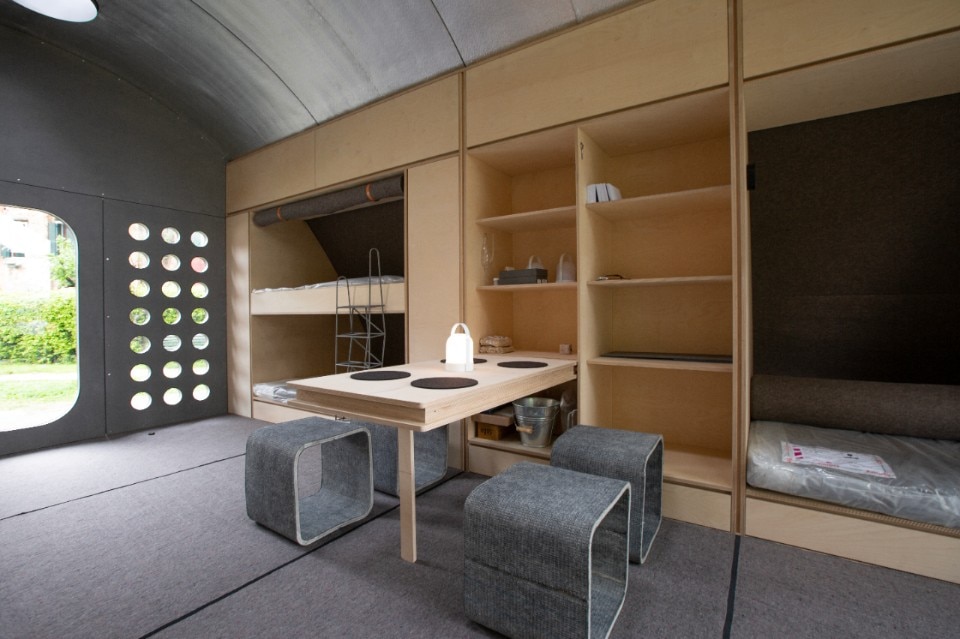
Norman Foster Foundation per Holcim, Essential Homes Research Project, 2023
Foto © Chiara Becattini
.jpg.foto.rmedium.png)
Norman Foster Foundation per Holcim, Essential Homes Research Project, 2023
Foto © Chiara Becattini
.jpg.foto.rmedium.png)
Norman Foster Foundation per Holcim, Essential Homes Research Project, 2023
Foto © Chiara Becattini
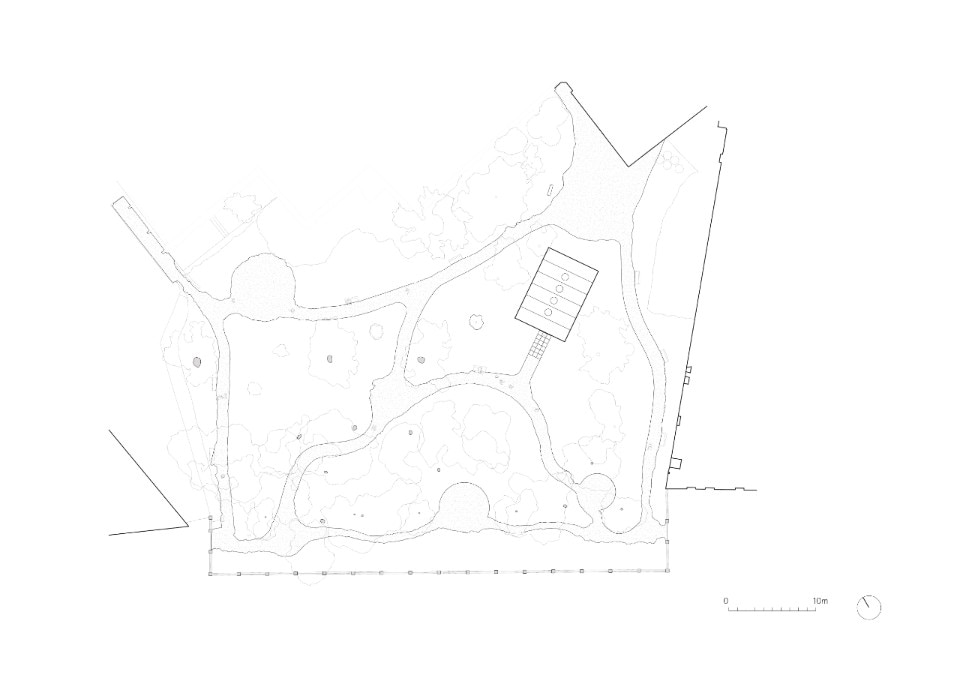
Norman Foster Foundation per Holcim, Essential Homes Research Project, 2023
Credits Norman Foster Foundation
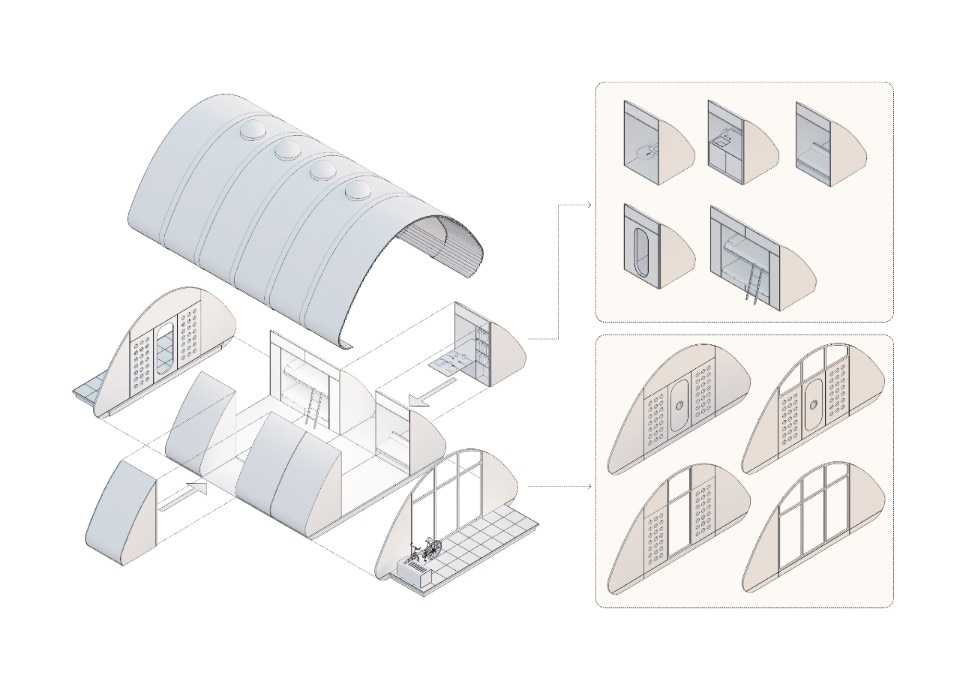
Norman Foster Foundation per Holcim, Essential Homes Research Project, 2023
Credits Norman Foster Foundation
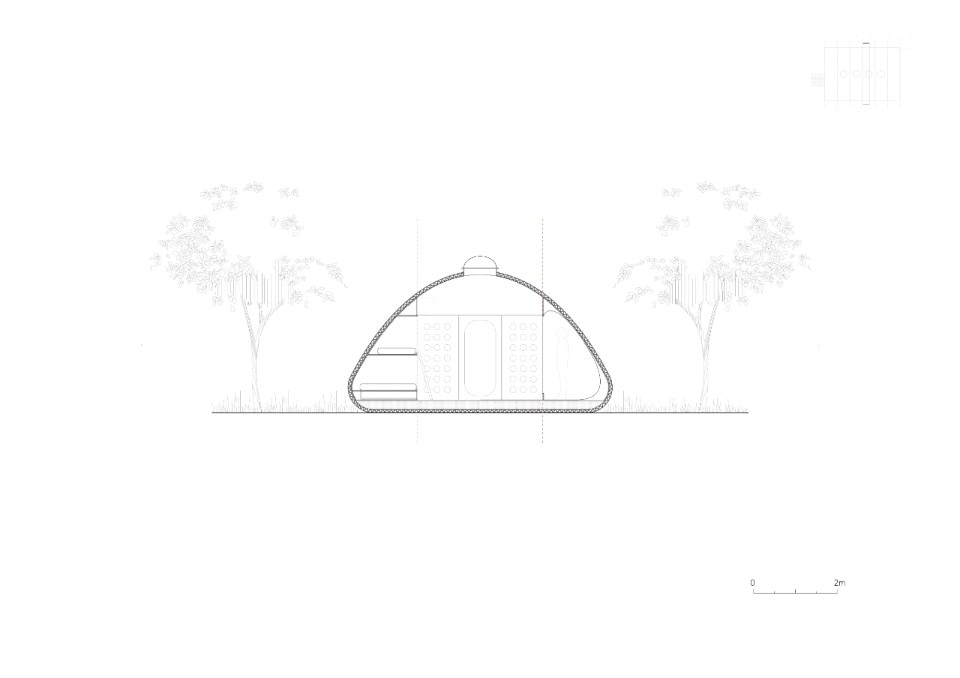
Norman Foster Foundation per Holcim, Essential Homes Research Project, 2023
Credits Norman Foster Foundation
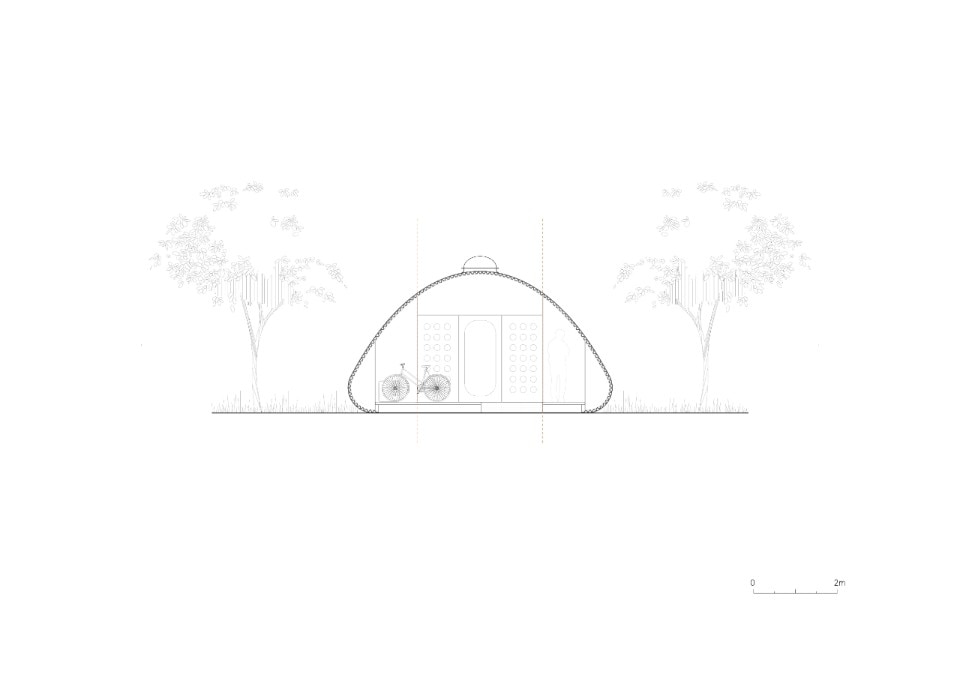
Norman Foster Foundation per Holcim, Essential Homes Research Project, 2023
Credits Norman Foster Foundation
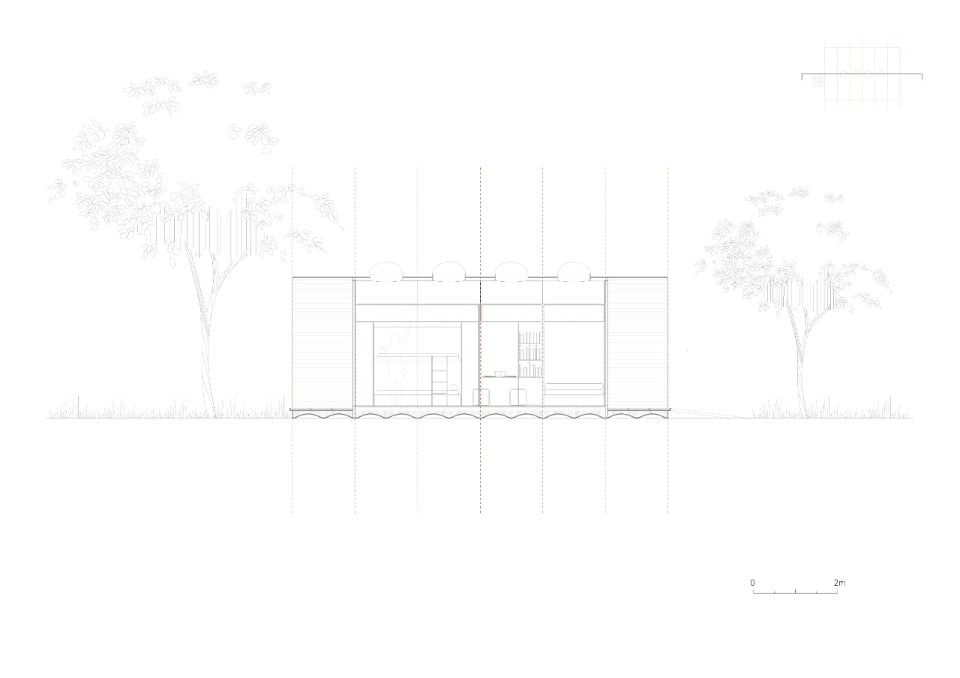
Norman Foster Foundation per Holcim, Essential Homes Research Project, 2023
Credits Norman Foster Foundation
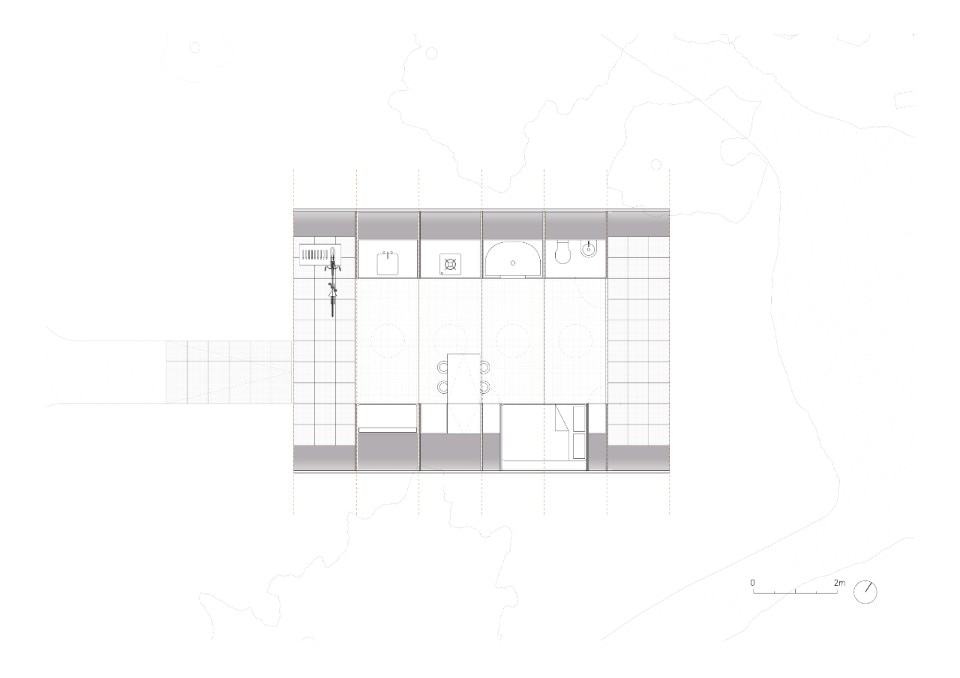
Norman Foster Foundation per Holcim, Essential Homes Research Project, 2023
Credits Norman Foster Foundation
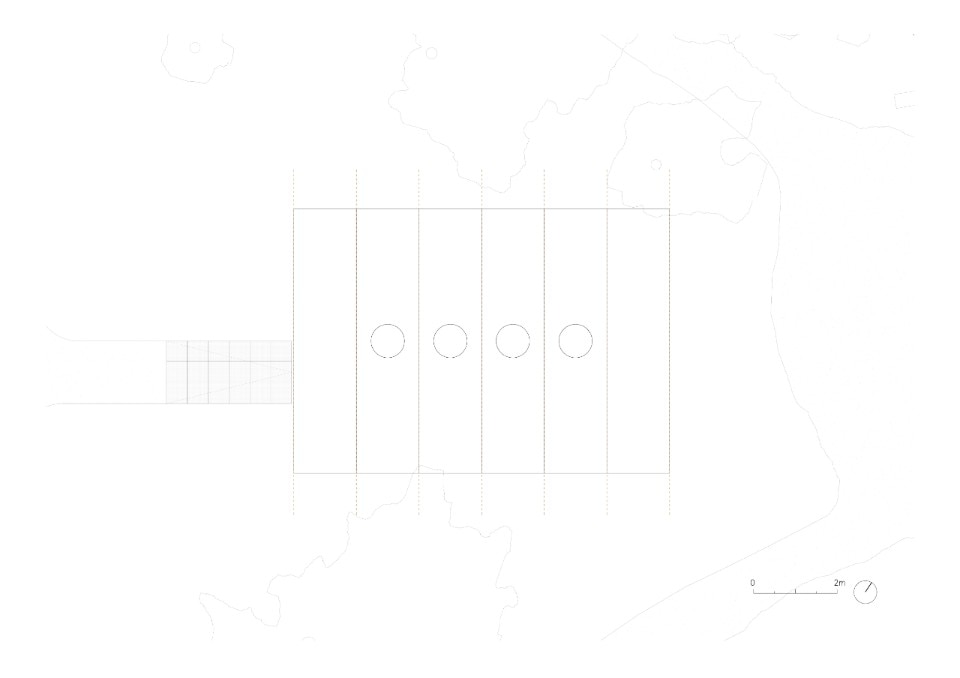
Norman Foster Foundation per Holcim, Essential Homes Research Project, 2023
Credits Norman Foster Foundation
.jpg.foto.rmedium.png)
Norman Foster Foundation per Holcim, Essential Homes Research Project, 2023
Foto © Chiara Becattini
.jpg.foto.rmedium.png)
Norman Foster Foundation per Holcim, Essential Homes Research Project, 2023
Foto © Chiara Becattini
.jpg.foto.rmedium.png)
Norman Foster Foundation per Holcim, Essential Homes Research Project, 2023
Foto © Chiara Becattini
.jpg.foto.rmedium.png)
Norman Foster Foundation per Holcim, Essential Homes Research Project, 2023
Foto © Chiara Becattini
.jpg.foto.rmedium.png)
Norman Foster Foundation per Holcim, Essential Homes Research Project, 2023
Foto © Chiara Becattini
.jpg.foto.rmedium.png)
Norman Foster Foundation per Holcim, Essential Homes Research Project, 2023
Foto © Chiara Becattini
.jpg.foto.rmedium.png)
Norman Foster Foundation per Holcim, Essential Homes Research Project, 2023
Foto © Chiara Becattini
.jpg.foto.rmedium.png)
Norman Foster Foundation per Holcim, Essential Homes Research Project, 2023
Foto © Chiara Becattini

Norman Foster Foundation per Holcim, Essential Homes Research Project, 2023
Foto © Chiara Becattini
.jpg.foto.rmedium.png)
Norman Foster Foundation per Holcim, Essential Homes Research Project, 2023
Foto © Chiara Becattini
.jpg.foto.rmedium.png)
Norman Foster Foundation per Holcim, Essential Homes Research Project, 2023
Foto © Chiara Becattini

Norman Foster Foundation per Holcim, Essential Homes Research Project, 2023
Credits Norman Foster Foundation

Norman Foster Foundation per Holcim, Essential Homes Research Project, 2023
Credits Norman Foster Foundation

Norman Foster Foundation per Holcim, Essential Homes Research Project, 2023
Credits Norman Foster Foundation

Norman Foster Foundation per Holcim, Essential Homes Research Project, 2023
Credits Norman Foster Foundation

Norman Foster Foundation per Holcim, Essential Homes Research Project, 2023
Credits Norman Foster Foundation

Norman Foster Foundation per Holcim, Essential Homes Research Project, 2023
Credits Norman Foster Foundation

Norman Foster Foundation per Holcim, Essential Homes Research Project, 2023
Credits Norman Foster Foundation
The Essential Homes Research Project is a collaborative effort between concrete producer Holcim and the Norman Foster Foundation, leading British architectural organization. For the Holcim team, this project focuses on creating a minimalist prototype for emergency situations but also provides an opportunity for technological innovation. The load-bearing shell of the Essential Home consists of a double layer of low-carbon rollable concrete sheets laid on lightweight formwork. This innovative solution offers several advantages, including rapid construction, with the shell solidifying in just 24 hours, and a significant reduction in emissions compared to traditional construction methods. Additionally, the recyclability of all components further contributes to its sustainability. Norman Foster’s expertise is evident in the clever configuration of the spaces – the design places services and bunks on opposite sides of a large tunnel-like open space, with transparent short sides. Holcim and Foster’s Essential Home stands out for proposing an innovative, intermediate option between the fragile and truly temporary solutions of tents and the often expensive and time-consuming nature of permanent buildings. The project’s only existing prototype was unveiled in conjunction with the 2023 Venice Biennale. The coming years will reveal whether and in what contexts this innovative minimalist home will be further multiplied.

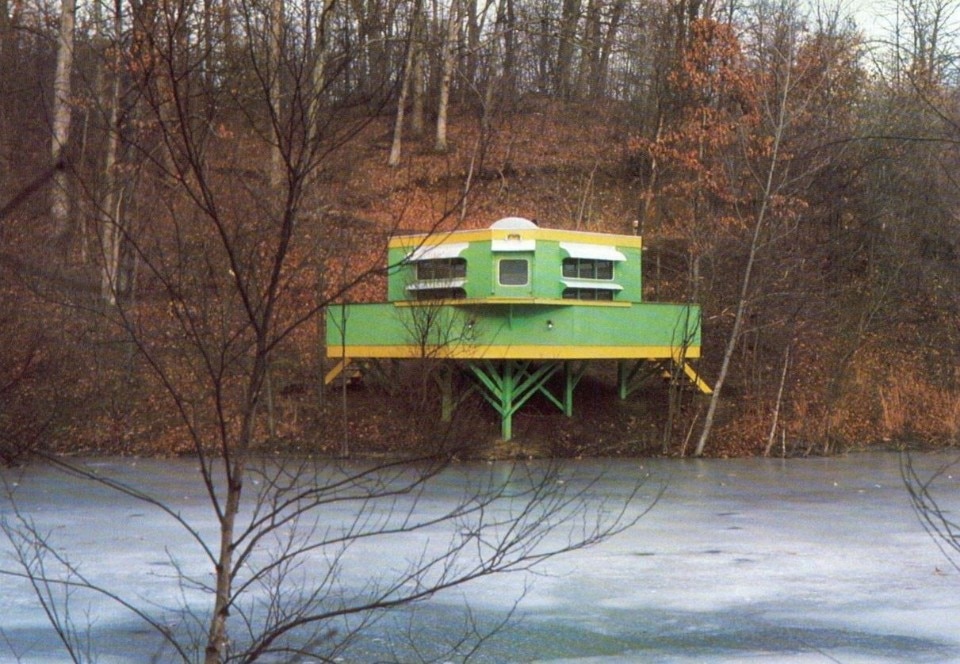
.jpg.foto.rmedium.png)
.jpg.foto.rmedium.png)
.jpg.foto.rmedium.png)
